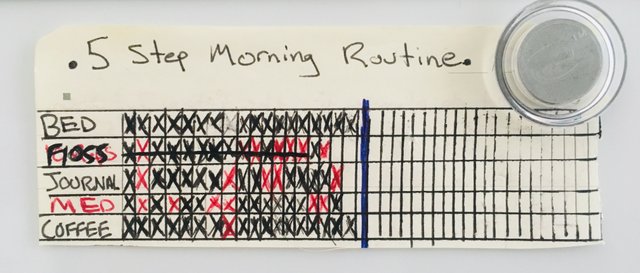The Many Ways Of Self Data
What better time to reflect on the past year than the no-mans-land between Christmas and New Years. Time doesn't exist and obligations only revolve around eggnog. I should start off by saying that not all of these forms of ambient or self-reported data will make it through to my process for 2019. But they all had their places as experiments this year. I want to spend less time tracking and more time using what works. The way I get to what works is by experimenting freely. In descending order from yearly ---> daily methods here we go....
Yes / No List
Timeframe: Annually
Big Take-Away: You need boundaries. And decision making power is a finite resource.
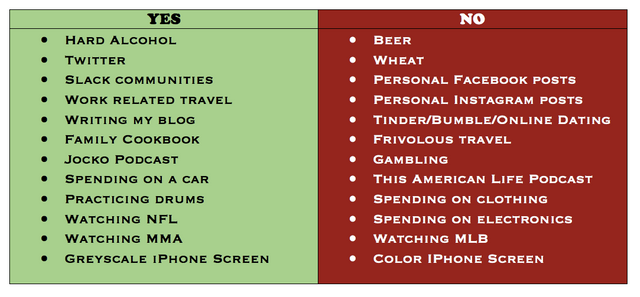
Yes/No, Start/Stop, Allowed/Restricted all convey the same idea. My 2018 process for this is written here. My 2019 process is dropping tomorrow. Instead of resolutions I decided at the beginning of 2018 what I was saying “NO” to, and inversely what I would say “FUCK YES” to. It covers everything from relationships to technology use to diet to what I let influence me. The best part about it is that there is no decisions to be made when something on my No list is offered to me. I know it’s off-limits for the year. The worst part is staying true to the list and deepening my resilience.
10x10 Goal Grids
Timeframe: Annually
Big Take-Away: Your goals should scare you. The road to getting there should not. and CELEBRATE somehow when you get there. Doesn’t matter how, but that positive reinforcement is powerful.
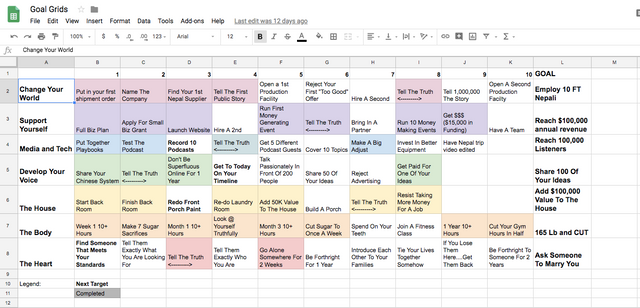
This one for sure requires a longer post, but a goal grid is basically my 10x10 grid paper (7x10 pictured) of ten overall personal and professional goals that I want to go after, broken down into ten steps to get me there, using a combination of audacious abstract sub-goals and tiny, approachable sub-goals so that I always have a clear “next step” to go after. There’s no humming and hawing when I sit down to work. If I don’t know what to go after, I just look up at the grid and pick something I can take a bite out of right now.
Need/Want Matrix
Timeframe: Bi-annually or more
Big Take-Away: Dichotomies are powerful. Matrices are God-Like.
My post about how to do a Need/Want Matrix is here. It’s really important to articulate the difference of these things in the physical world. Needs and Wants get so very mixed up inside your head when mediated by environment and emotional state. What clear is that you’re going to have to put extra effort into the things you Need, but Don’t Want and you’re going to have to be disciplined about rationing your exposure to the things you Want, but Don’t Need. Get after it.
Moment App
Timeframe: Weekly reporting, daily tracking
Big Take-Away: The less screen time spent, the better I feel.
[Moment app] (https://inthemoment.io/) tracks my app usage and screen time on both my phones. In my most productive weeks I set my goal at 15 minutes of phone time per day. Often failing this, when I get close to the 30 minute mark I’m a pretty happy and productive camper. Obviously things like travel, content creation and other business obligations will compete with this, but it’s still better to have some kind of a target rather than letting my craving for dopamine dictate how much time goes down the technicolor rabbit hole.
Weekly Update
Timeframe: Weekly
Big Take-Away: I need my blindspots addressed. I need to be held accountable.
I meet with a co-mentor group each week for the last two years via video conference. Our pre-work is doing a 1-2 page comprehensive update on the previous week and where we want our upcoming week to go. Body, Being, Breakdowns and Breakthroughs are reported on. Fears are laid out, nagging questions are addressed and everybody pulls apart each others reports, providing feedback and looking for the strong or the weak.
Weekly Reminders
Timeframe: Weekly
Big Take-Away: Sometimes a shitty throw away line is enough to give you a charge.
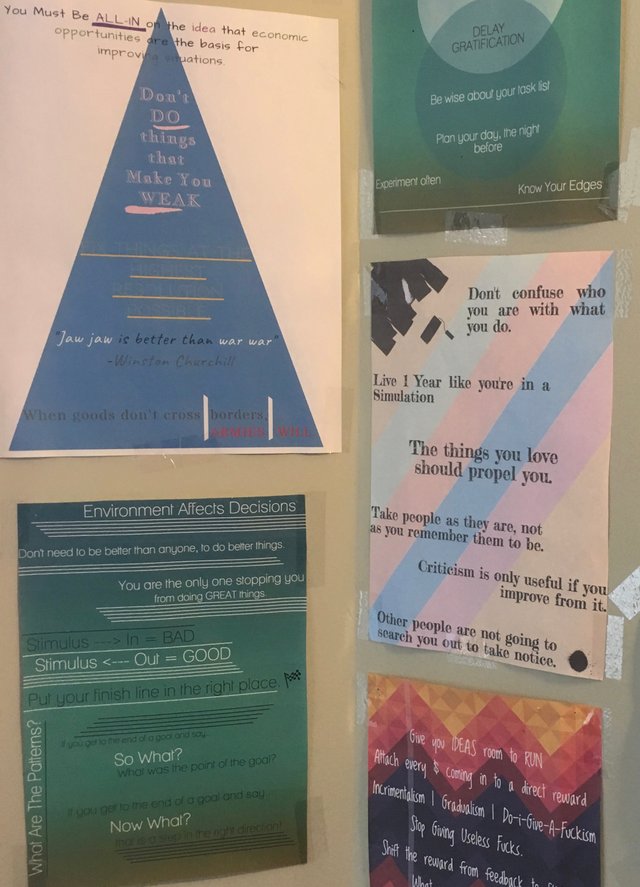
When I hear something good, or think of something encouraging I write it on my white board. Then at the end of the week I put those lines onto a graphic one pager using piktochart.com and tape it to the wall. I get my board space back and I don’t lose that “wisdom” of the moment. I’m just not smart enough to remember everything I told myself and why it was powerful in that moment, so these little one-pagers keep memes out of my head but in my environment.
Journal
Timeframe: Daily
Big Take-Away: Cage the Monkey on the Page
A journal is a critical piece of output for my morning routine. It’s not what you write, it’s that you’re writing. Allow your undirected energy and ideation to go somewhere. Keep it from banging around inside your head all day while you should be focused on something greater.
Domino Task Lists
Timeframe: Typically Daily
Big Take-Away: You feel better tackling the one big thing on your list than 8 of the tiny bottom-feeding things.
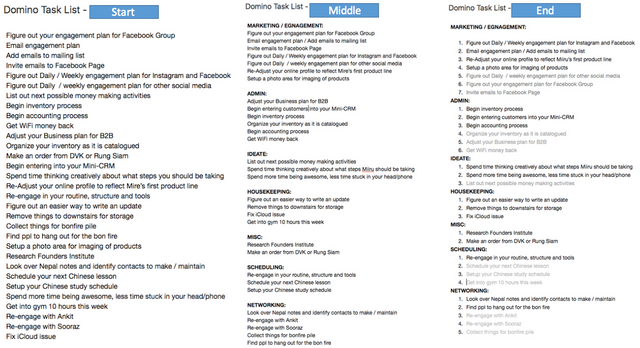
A Domino Task List is where you write out everything you need to get done, group similar items together, and then re-order groups via a specific prioritization. The ranking I used was “Which of these things if accomplished, will make the other things irrelevant.” Original credit for this is Tim Ferriss who may credit someone else with the idea. If you do this prioritization right, going after #1 on your list is always the most strategic, most effective thing you can take on. As your business or project grows, doing this exercise correctly can have a huge impact on resource mgmt, hiring, delegation and much more.
Morning Routine 5 box check-list
Timeframe: Daily
Big Take-Away: Win the morning, win the day.
It’s not what the routine is, but the fact that there is a routine at all to my morning that makes a difference. Simple stuff - wake up early, make the bed, drink coffee, journal and try to meditate. It’s a primer. A state change from asleep to alive. And after long enough it becomes a ritual that is done without need for decisions or prompting.
168 Hour Project
Timeframe: Hourly
Big Take-Away: Weeks of highest output/focus correlate to my highest feelings of positive emotion.
I’ve written a whole blog about why I do this, but in short I needed to create an external, tactile system to give me a better connection to what each hour of my life was worth. After about 3 months of putting $1 coins into different cubbies I internalized the practice and was able to go through my day regularly think about each hour as utilized, spent, or wasted. I collect the data at the end of the week and annually can take educated guesses at what puts me in my best states for work, love, growth and creation.
That's it folks. Thanks for reading!
Check out my few other posts on Steem @
- https://steemit.com/startup/@almostfitz/experimenting-with-the-bogo-3-0-business-model
- https://steemit.com/startup/@almostfitz/why-this-business-data-confidence-and-shit-testing
- https://steemit.com/startup/@almostfitz/why-this-business-set-your-anchors-deep
- https://steemit.com/travel/@almostfitz/tourists-pull-your-head-out-of-your-ass
- https://steemit.com/worst/@almostfitz/the-potential-freedom-in-being-the-world-s-worst-entrepreneur
- https://steemit.com/storage/@almostfitz/the-self-storage-industry-feeds-off-laziness-save-money-by-organizing
- https://steemit.com/business/@almostfitz/open-for-business-11-pictures-about-launching-a-startup-speak-11-000-words
- https://steemit.com/shark/@almostfitz/i-binged-5-seasons-of-shark-tank-and-got-something-out-of-it
- https://steemit.com/dnn/@almostfitz/dnn-the-good-the-bad-and-the-ugly-on-how-to-create-a-decentralized-free-news-platform
- https://steemit.com/writing/@almostfitz/free-writing-cage-that-monkey-mind-and-get-creative
- https://steemit.com/data/@almostfitz/stop-wasting-time-168-hours-tracking-system
Check out my posts on my other blog on my Shopify store @
